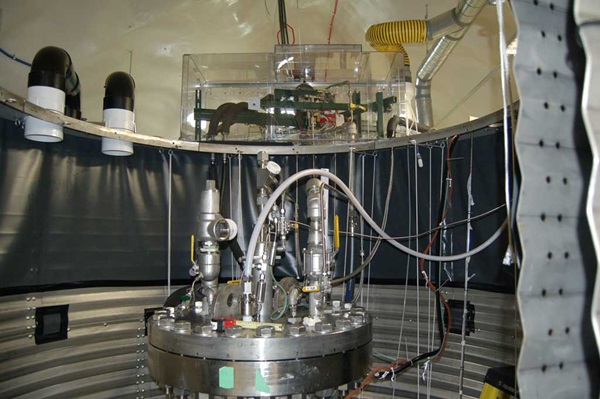Key Takeaways:
Scientists will need further analysis to discern whether dark matter caused any of the COUPP-60 experiment’s first bubbles.
“Our goal is to make the most sensitive detector to see signals of particles that we don’t understand,” said Hugh Lippincott with the Department of Energy’s (DOE) Fermi National Accelerator Laboratory in Batavia, Illinois, who has spent much of the past several months leading the installation of the one-of-a-kind detector in a laboratory a mile and a half underground.
COUPP-60 is a dark matter experiment funded by DOE’s Office of Science. Fermilab managed the assembly and installation of the experiment’s detector.
The COUPP-60 detector is a jar filled with purified water and CF3I — an ingredient found in fire extinguishers. The liquid in the detector is kept at a temperature and pressure slightly above the boiling point, but it requires an extra bit of energy to actually form a bubble. When a passing particle enters the detector and disturbs an atom in the clear liquid, it provides that energy.
Dark matter particles, which scientists think rarely interact with other matter, should form individual bubbles in the COUPP-60 tank. “The events are so rare, we’re looking for a couple of events per year,” Lippincott said.
Other, more common and interactive particles such as neutrons are more likely to leave a trail of multiple bubbles as they pass through.
Over the next few months, scientists will analyze the bubbles that form in their detector to test how well COUPP-60 is working and to determine whether they see signs of dark matter. One of the advantages of the detector is that it can be filled with a different liquid if scientists decide they would like to alter their techniques.
The COUPP-60 detector is the latest addition to a suite of dark matter experiments running in the SNOLAB underground science laboratory located in Ontario, Canada. Scientists run dark matter experiments underground to shield them from a distracting background of other particles that constantly shower Earth from space. Dark matter particles can move through the mile and a half of rock under which the laboratory is buried, whereas most other particles cannot.
Scientists further shield the COUPP-60 detector from neutrons and other particles by submersing it in 7,000 gallons of water.
Scientists first proposed the existence of dark matter in the 1930s, when they discovered that visible matter could not account for the rotational velocities of galaxies. Other evidence, such as gravitational lensing that distorts our view of faraway stars and our inability to explain how other galaxies hold together if not for the mass of dark matter, has improved scientists’ case. Astrophysicists think dark matter accounts for about a quarter of the matter and energy in the universe. But no one has conclusively observed dark matter particles.










